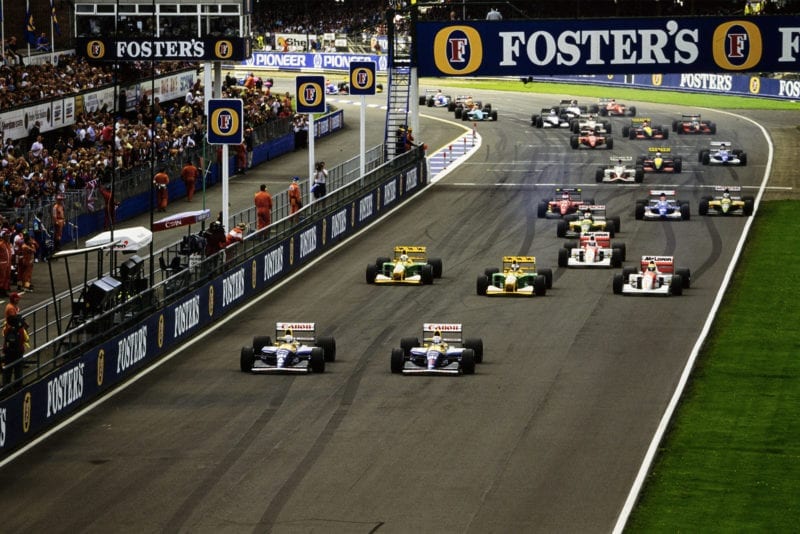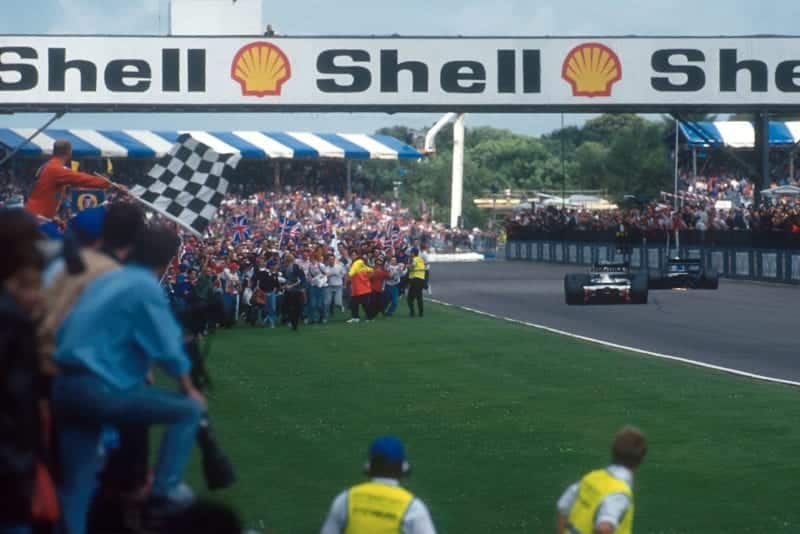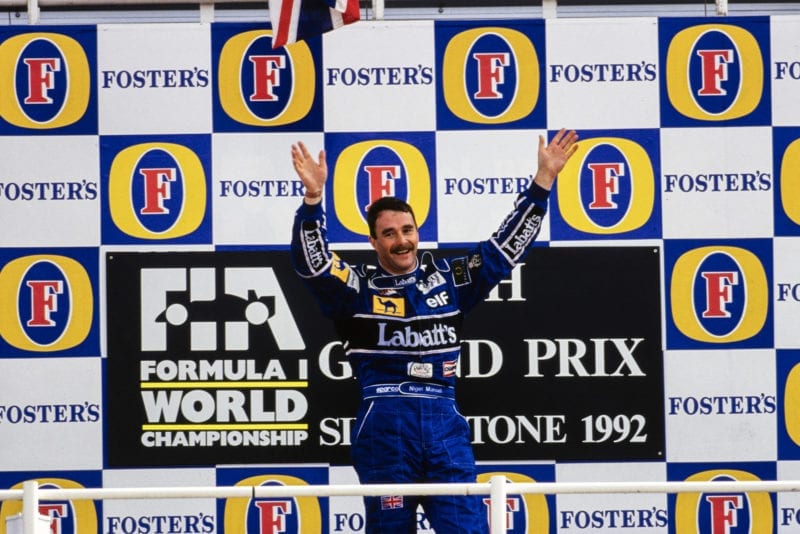1992 British Grand Prix race report - Game, Set And Mansell
Pole by two seconds, the lead throughout and a string of fastest laps; nothing could stop Nigel Mansell on home ground
Nigel Mansell gave the British spectators precisely what they craved at Silverstone on July 12 — and nearly got a lot more than he bargained for as he crossed the start/finish line after 59 totally dominant laps.
The Briton had driven the almost perfect race. Only the first few hundred yards escaped his total control, as he spun his rear tyres a fraction more than team-mate Riccardo Patrese and the Italian sprinted ahead.
Mansell had been two full seconds faster than Riccardo in the only dry qualifying session on Friday, admitting afterwards that he did not believe it possible that he could better the dramatic 1m 18.965s lap that won him the 25th pole position of his career. Thus it was expected, particularly in the wake of team tactics in Magny Cours, that even if Riccardo did lead initially he would not be able to offer a consistent challenge. Whether that was because of technical, voluntary or physical restrictions was a moot point. The word on Friday was that although the two FW14Bs had Renault RS4 engines, Mansell’s was the very latest evolution, something guaranteed to strike terror deep into Honda as Senna wound up a full three seconds off Mansell despite a similarly heroic qualifying performance. Riccardo, predictably, was honest enough to admit that while he might have pared his 1m 20.886s lap to something in the high 19s, a high 18s lap was quite beyond him.

The Williams team-mates go side-by-side in a fight Nigel Mansell would win
Motorsport Images
He started the race in a degree of discomfort after his fourth successive British GP practice shunt (and his third biggie of the season after failure-induced incidents testing at Estoril and Imola). On Saturday morning he had been the innocent victim of a very unpleasant little accident at Vale when Erik Comas inadvertently missed seeing yellow flags where a gearbox problem had spun Bertrand Gachot’s Venturi-Lamborghini. As Patrese slowed Comas dived inside the Williams and clipped it. The Ligier spun and hit the outside wall very hard, bruising Comas’ right leg, before coming to rest in the middle of the track. The Williams hit the wall at an oblique angle, giving Riccardo a violent shaking. Had the angle been more acute the consequences could have been much more serious, as he could have gone in almost head-on. It’s a point that Silverstone ought to have a think about.
With all that taken into account and mixed with Mansell’s brimming confidence on home ground, the result was really a foregone conclusion. By Becketts he had simply flown past his team-mate and thereafter he motored into the distance, setting a string of fastest laps. He even had time for a controlled tyre stop on lap 30, such was his phenomenal advantage, and by the time he took the chequered flag first for the seventh time this year — and the 28th time in his burgeoning career — his margin of victory was 39s.
That was when it all so nearly went badly wrong. Ever since John Watson won the British GP in 1981, British fans have lost their traditional reserve and cheered themselves hoarse in true tifosi style. And good luck to them. It’s been a nice touch, as has the way in which, over the years after a Mansell victory at home, the fans have come on to the track to offer their congratulations before making their way back to their original spectating positions ready for the next race. It’s been a curious mixture of elation and manners, and to its credit Silverstone has always understood it and respected it. This year, having studied post-race videos of the 1991 event in conjunction with the police and concerned therefrom that some spectators might be crushed, it specifically asked fans to exercise commonsense in the programme and via the specialist press. It wasn’t telling them not to go on to the track; but to go only when given the all-clear by the stewards or marshals.

Ayrton Senna wrestles for control of McLaren alongside Martin Brundle
Motorsport Images
That, sadly, was not enough for one brain-damaged Nigosi. The moment Mansell’s car crossed the line this reckless individual dashed straight across the track, and that was the signal for legions to follow. The race was still going on behind, with Patrese heading for second place and others dicing hard for position, but the actions of the foolhardy brought the racers to a crawl. By a miracle nobody was hurt, but Mansell actually ran over one beefy character as the latter tried to hand his hero a Union Jack and was literally sucked under a rear tyre. Fortunately he did not sustain lasting injury.
There was another motor race at Silverstone last Sunday afternoon, behind the Williams duo, and it was terrific. After Schumacher had outgunned Senna at the start and squeezed over to the left of the track to hold the McLaren wide, Brundle saw the perfect opportunity and nipped cannily down the inside to snatch third place. Schumacher then came back at him at Becketts but at the cost of a wide exit line that took him over the gravel and a kerb and dropped him behind his team-mate and both McLarens. Then at the end of the lap, Berger ran wide at Luffield and both Schumacher and Johnny Herbert in the Lotus 107 slipped ahead, leaving the Austrian just out of the points and ahead of Alesi’s Ferrari, Comas’ Ligier which had had to lock its brakes to avoid the Schumacher/Senna jam on the startline, and Hakkinen’s Lotus. The stage was set.
Hakkinen began the fun, fired up after a morning altercation with traffic police on his way to the circuit, and though the television director clearly missed it all, his pursuit of Comas and Alesi was electrifying. The Ligier pilot succumbed early, on lap five, the Alesi as usual was tough. They came out of Chapel and on to the Hangar Straight on lap 21 and the Lotus drew alongside but for agonising moments it just hung there and then the Ferrari began to creep back ahead. Hakkinen, however, had the inside line for Stowe.

Michael Schumacher on his way to fourth in the Benetton
Motorsport Images
“As he was pulling back ahead I was thinking to myself ‘What’s this?’ but I really kept going for it and we went into the corner side by side and finally he had to back off. He had no choice!”
Just as in Magny-Cours he had passed the F92A in a straight fight, and thereafter he started to make inroads into Berger’s advantage. Closer to the front, Brundle had a breathing space to Senna, but the Brazilian had Schumacher crawling all over the back of the McLaren. Senna had opted for more downforce in an attempt to tame the MP4/7A in the corners, and on the straights both B192s had the advantage. But the World Champion knows how to keep people behind, and after their altercation in France there was no way he was going to be upstaged by the German. As the pressure on him grew they began to close slightly on Brundle, who was driving the best race of his F1 career. Since Monaco his form has picked up dramatically. “This isn’t the real Martin Brundle you’re seeing,” he had said earlier in the year when he was having real trouble, and sure enough here in Silverstone, just as he had done in Canada and France, he was proving that as a racer rather than a qualifier he is getting much closer to his peak.
He and Senna know each other well from their F3 days, and the latter had the grace to express the fact that he was impressed again by what he saw that Sunday afternoon. “We had a good, clean fight and he warmly deserved the place,” he said. He was pushing as hard as he could, but the truth was that McLaren-Honda had again lost ground to Benetton Ford and the stalemate remained. What stopped it being boring was that Senna never gives up. There was an F3 race between the two at Donington in July 1983, where Martin led throughout with Ayrton never more than a few feet adrift. This was a little bit like a grown-up version of that. Watching their dice you could never afford to relax because the situation could change at any moment. One could only imagine what Brundle was thinking at the time, but afterwards he expressed his delight. “I thoroughly enjoyed that race! The car was superb, not a single problem. With Ayrton pushing me like that it seemed like a very long race, and I’m really pleased to have been able to withstand the pressure.”

Mansell scores a second-straight home victory at Silverstone
Motorsport Images
When Mansell made his tyre stop it was also planned that Patrese would come in, but inspection revealed that the lead Williams didn’t really need new rubber, so Riccardo stayed out. So too did Brundle and Senna. While the active FW14B was kinder to its rubber, however, both Martin and Ayrton began to pay the price as the race drew to its finish. “My tyres began to pay the price for not running quite so much wing as Ayrton did,” said Brundle, his B192 sliding wildly at times. “I was worried about my tyres,” said Ayrton. “For the last 15 laps I had a lot of vibration and could hardly see the track.”
Further back Berger and Schumacher played it safe. The Austrian came in on lap 29 and dropped from seventh to ninth as Hakkinen and Alesi went by. Schumacher came in four laps later for a very quick stop, dropping to sixth behind Hakkinen. The German had locked his front brakes twice early in the race, after that trip over the kerb trying to repass Brundle, and he’d decided to come in when he felt some vibrations from the tyres. Hakkinen, however, realised that he might just have a chance of going non-stop and profiting since his Lotus was getting better and better as the race progressed, but team-mate Herbert was fated to have another disappointing day. Realising full well that keeping his Goodyears alive was going to be the key to a good finish — and realistically Lotus might have aspired to fourth place — he took care to preserve his rubber in the early stages, even though he managed to keep ahead of Berger without apparent strain, and was closing on the Brundle/Senna/Schumacher battle by lap 30 when the gap to the second B192 had shrunk to only four seconds.
“I think I’d have caught Martin, Ayrton and Michael to be honest,” he later revealed, “because although they were running in traffic while I was closing, I was also having to pass backmarkers.” Sadly he crept in to retire after 31 laps when his gear selection went awry.

Fans invade the track in excitement after seeing Mansell win
Motorsport Images
Now it was not just the Brundle/Senna duel that kept the crowd on its toes as Mansell sailed round at the head of the field, for Berger and Schumacher were getting after Hakkinen as the Finn began to appreciate around lap 45 that his tyre gamble wasn’t going to work after all. By then Berger had profited when Schumacher made a mistake at Luffield on lap 40 and punted the innocent Stefano Modena into spin, and as Hakkinen began to slide more and more Gerhard finally made it by on lap 49 as he got alongside Mika going into Stowe. That same lap Michael also overtook the Lotus with a very nicely judged move that set him up for the inside line going into Bridge.
Senna’s dogged pursuit of Brundle finally paid dividends through no fault of Martin’s on lap 53, when as Tarquini lapped Hill and were both in turn lapped by the Benetton and the McLaren, Damon inadvertently chopped across on the B192 and obliged Brundle to lift off. No sooner had Senna dived through, however, than his transmission failed, so Brundle deservedly went to the third place ball after all.
There was more misfortune still for McLaren as Berger’s engine, which had been running hot for the last three laps, finally blew up at Luffield last time round, letting Schumacher through for fourth. Hakkinen took a point for sixth, with Alboreto seventh yet again and heading a long duel between Comas and Capelli’s underpowered Ferrari.
Further back, an equally entertaining battle for 10th finally went to Boutsen from Grouillard, Suzuki anciLehto. Alesi’s troubled day had finally ended on lap 44 when the fire extinguisher set itself off in the cockpit of the Ferrari and the cold gas blowing on to his legs forced Jean to pull off and retire at Maggotts.
Tarquini and Martini were the remaining finishers, the former having run well all weekend until a clutch problem hampered him, while Hill soldiered round in the Brabham to complete his first GP, 17 years to the race at which his illustrious father had announced his retirement from active driving.

Mansell laps up the home crowds adulation on the podium
Motorsport Images
Thus, amid the scenes of chaos, the British Grand Prix became yet another annihilation by Williams Renault and another demonstration that when things are running right for him Nigel Mansell can be thoroughly unbeatable. It was a well-judged victory, and thoroughly deserved, and threw McLaren Honda into further turmoil as Benetton Ford usurped the MP4/7As. “We knew it was going to be hard but not this hard!” said a resigned Ron Dennis.
“I have never seen a British crowd so enthusiastic,” beamed Mansell as he savoured a success than took him past Jackie Stewart as the most successful British driver. A pale sun shone, the victory had taken him yet one more step towards the World Championship, and had underlined once more the dominance of the driver/car combination. Senna had slunk away threatening to quit if he couldn’t find a team that could provide him with the right technical support, and everything in the garden seemed rosy. The only cloud on the Briton’s horizon was a little Frenchman called Alain Prost, whose name was connected more and more strongly with a Williams seat for 1993… D J T
DRIVERS’ WORLD CHAMPIONSHIP
1. Nigel Mansell (76); 2. Riccardo Patrese (40); 3. Michael Schumacher (29); 4. Gerhard Berger (20); 5. Ayrton Senna (18); 6. Martin Brundle (13); 7. Jean Alesi (11); = 8. Mika Kakkinen (5); = 8. Michele Alboreto (5); 10. Andrea de Cesaris (4); = 11. Eric Comas (3); = 11. Karl Wendlinger (3); = 13. Ivan Capelli (2); = 13. Johnny Herbert (2); = 13. Pierluigi Martini (2); = 16 Bertrand Gachot (1)
